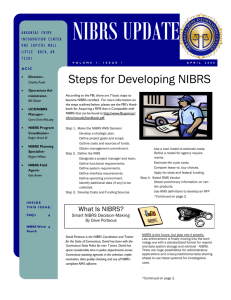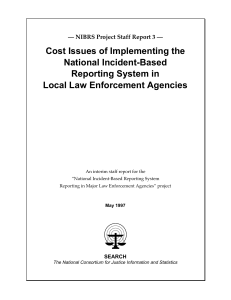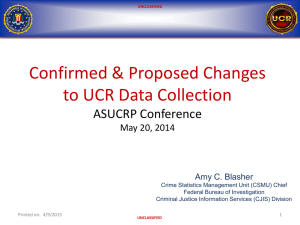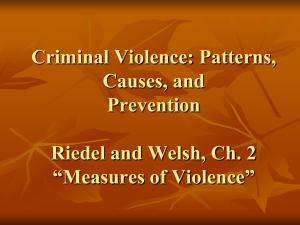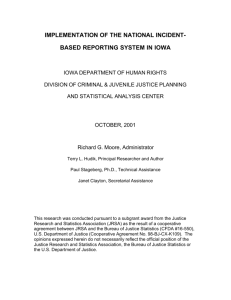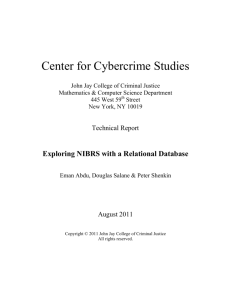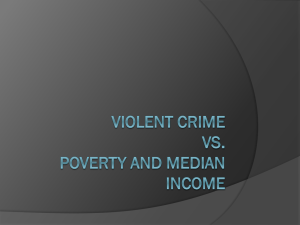NCS-X - asucrp
advertisement
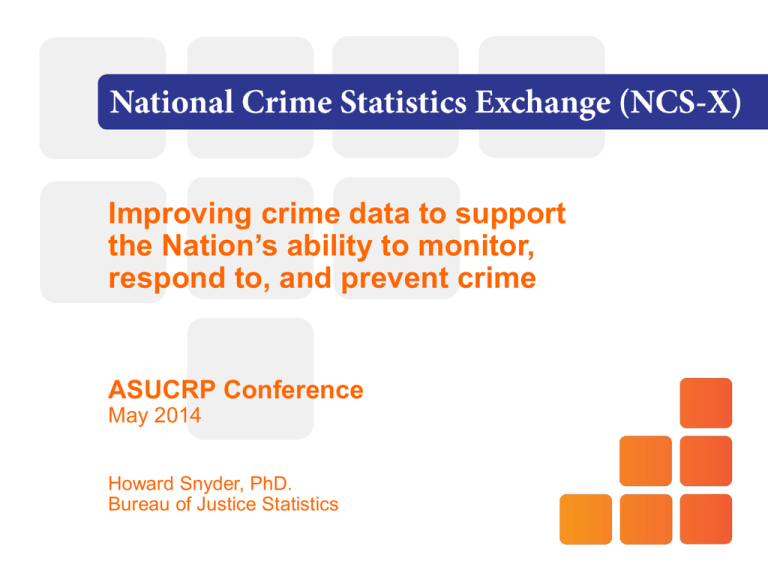
Improving crime data to support the Nation’s ability to monitor, respond to, and prevent crime ASUCRP Conference May 2014 Howard Snyder, PhD. Bureau of Justice Statistics NCS-X – National Crime Statistics Exchange Effort to generate nationally-representative, incident-based data on crimes reported to law enforcement agencies Leverages existing infrastructure of the FBI’s National Incident-Based Reporting System (NIBRS) Seeks to expand participation in NIBRS by combining data from existing NIBRS agencies with data from a scientific sample of 400 additional agencies Goal is to provide timely and accurate detailed national measures of crime from state and local police agencies Will generate crime statistics that go beyond Part I crime categories 2 NCS-X Partners BJS is spearheading NCS-X, in close coordination with the FBI and support from other DOJ agencies NCS-X Partner Agencies Diverse set of partner organizations responsible for developing implementation plans 3 Benefits of improving national data on reported crime ASUCRP Conference May 2014 Amy Blasher Federal Bureau of Investigation FBI, UCR Program and NCS-X In June of 2013, the FBI’s CJIS Division Assistant Director and the BJS Acting Director signed a joint statement in support of the National Crime Statistics Exchange (NCS-X). FBI and BJS, both components of the Department of Justice, “…share statutory responsibility for developing national estimates of crime known to law enforcement and the characteristics of criminal incidents.” The FBI CJIS Division supports the NCS-X goal of improving incident-based crime reporting by recruiting an additional 400 law enforcement agencies to report to NIBRS. 5 Status of NIBRS reporting in the states UCR Program NIBRS Participation (Program Counts) NIBRS Program Status 14 15 100% NIBRS 90-99.99% NIBRS 80-89.99% NIBRS 3 12 2 1 0 4 70-79.99% NIBRS 60-69.99% NIBRS 50-59.99% NIBRS Data Collection Agency Format Count NIBRS 6,316 Summary (Electronic) 8,790 Summary (Paper) 1,269 Total 16,375 Total NIBRS 38.6% 0.10-39.99% NIBRS 0% NIBRS 6 Increasing NIBRS reporting in <100% reporting states States fall into one of three categories related to NIBRS reporting in states that are not 100% NIBRS Category 1: Some agencies report NIBRS data to the state UCR program These are considered “hybrid” states – where they submit both NIBRS and Summary formats depending on the collection program; This can impact FBI UCR Program business rules management – requiring separate rule sets for states with different data formats being submitted. 7 Increasing NIBRS reporting in <100% reporting states Category 2: The state has a state UCR program, but no agencies report NIBRS to the state. 2 states have 1 or more agencies that report NIBRS directly to the FBI (but not to the state). 4 of these states have expressed interest or are currently in the process of moving to 100% NIBRS Category 3: The state has no state UCR program. 8 NCS-X Initiative implementation The FBI is working with BJS and other NCS-X partner agencies to implement NCS-X Participating in efforts to recruit sample law enforcement agencies; Engaging with state and local police departments about converting to NIBRS compliant reporting; Encouraging state CJIS Systems Officers to play a key role in establishing NIBRS as the law enforcement standard for crime statistics. 9 NCS-X program update and status of implementation efforts ASUCRP Conference May 2014 Erica Smith Bureau of Justice Statistics Status of NCS-X Initiative Phase I Initiative activities include: reaching out to stakeholders and existing state incident-based reporting programs to gain their insight and support; recruiting a sample of 400 law enforcement agencies for participation; identifying barriers and developing incentives and resources that will encourage candidate agencies to participate in NCS-X; and developing cost and feasibility guidelines for implementation. 11 NCS-X Phase 1 activities Phase I Initiative activities include: reaching out to stakeholders and existing state incident-based reporting programs to gain their insight and support; recruiting a sample of 400 law enforcement agencies for participation; identifying barriers and developing incentives and resources that will encourage candidate agencies to participate in NCS-X; and developing cost and feasibility guidelines for implementation. 12 Stakeholder engagement Interviews conducted with UCR Coordinators in every state Understand the organization of each state’s UCR/NIBRS program; Gather key information about how incident-based data are: collected from local law enforcement agencies; processed by the state UCR program; and transmitted to the FBI. Key findings from interviews: Limited analysis at the state level using IBR data Some summary only states have begun an IBR initiative State statutes with “teeth” encourage reporting 13 Stakeholder engagement Engaged with RMS service providers to learn about the complexities and costs of adding NIBRS reporting to their products Information from RMS vendors that account for over 4,000 installed systems in law enforcement Key findings: There are 31 states in which interviewed companies claimed to provide NIBRS reporting capabilities. Lack of standardization in IBR data elements across states is a challenge for the RMS service providers. 14 Stakeholder engagement Development and implementation of NCS-X Marketing Plan Stakeholder engagement opportunities Showcasing strengths and uses of IBR and NIBRS participation across stakeholder audiences Law enforcement Victim service organizations Federal, state, and local government agencies Policy makers Developing reports and analytic tools useful to various stakeholder groups 15 NCS-X Phase 1 activities Phase I Initiative activities include: reaching out to stakeholders and existing state incident-based reporting programs to gain their insight and support; recruiting a sample of 400 law enforcement agencies for participation; identifying barriers and developing incentives and resources that will encourage candidate agencies to participate in NCS-X; and developing cost and feasibility guidelines for implementation. 16 Selecting NCS-X sample agencies Sample consists of 400 main agencies and 300+ reserve (substitute) agencies: Stratified random sample; Grouped into 12 strata by agency type and number of sworn officers; Agencies were randomly selected within each stratum; Tribal agencies represented in separate stratum; 72 largest agencies selected with certainty. 17 NCS-X Sample Selection Stratum 1: Current NIBRS participants Strata 2 through 12 consist of nonNIBRS agencies: 2. 750 officers or more; 3. State, 1-749 officers; 4. State or Municipality, 0 officers; 5. County or Township, 36-749 officers; 6. County or Township, 0-35 officers; 7. Municipality, 181-749 officers; 8. Municipality, 61-180 officers; 9. Municipality, 16-60 officers; 10. Municipality, 1-15 officers; 11. Remainder non-Tribal agencies; 12. Tribal. Existing NIBRS reporting agencies 6,000+ Agencies selected in NCS-X sample and enrolled in NIBRS 400 Nationally representative crime statistics using the NIBRS dataset 18 Surveys to sample agencies Surveys were sent to NCS-X sample agencies Includes questions about current RMS technology in use by sample agencies; Will uncover feasibility of enhancing current systems and/or replacing them; Responses will be used to help develop incentives and resources to encourage participation. Response rate to date: 75% of the largest agencies (750+ sworn); 54% of agencies in remaining strata; 22% of Tribal agencies in stratum 12 19 NCS-X Phase 1 Activities Interviews with all State UCR Coordinators— Completed Discussions and coordination with RMS vendors— Completed Survey of the 400 NCS-X sampled agencies— In Progress Agency survey fielded beginning March 2014 Approximately 57% of agencies have completed the survey Development of incentives for participation— Ongoing Pilot testing with selected states and agencies— Summer 2014 20 Status of NCS-X Initiative Phase I Initiative activities include: reaching out to stakeholders and existing state incident-based reporting programs to gain their insight and support; recruiting a sample of 400 law enforcement agencies for participation; identifying barriers and developing incentives and resources that will encourage candidate agencies to participate in NCS-X; and developing cost and feasibility guidelines for implementation. 21 Partnering with States and Next Steps for NCS-X ASUCRP Conference May 2014 Kevin J. Strom, PhD. RTI International Importance of States to NCS-X States are critical partners in collecting, processing, and analyzing incident-based data. NCS-X is committed to building capacity at the state level in support of moving sampled agencies to NIBRS. Currently in a feasibility and pilot testing phase where we are able to work with selected states. As implementation progresses and funding is available, our intention is to work with all states. 23 Current Outreach to States States broadly fall into 3 categories with respect to incident-based reporting and NIBRS - No current NIBRS capacity – NCS-X is developing a TA/ConOps framework that will help guide states who are asking: “What would it take to build NIBRS capacity in our state?” Limited/some NIBRS reporting – Provide support to states in expanding IBR and in recruiting sampled agencies. 100% NIBRS reporting – Planning to develop web-based analytical portal that would be available to all reporting states and agencies. Seek input from these states on tool specifications along with recommendations and lessons learned for implementing or expanding IBR data collection. 24 State Progress: Illinois IL IL Criminal Justice Information Authority (ICJIA) is key partner along with IL State Police. ICJIA recognizes that IL needs improved crime reporting and is working to advance IBR within IL. In-person meetings with IL agencies including NCS-X sampled agencies (most recently on 4/30). Have engaged Chicago PD through ICJIA to obtain their participation – Technical assessment visit in the next 2-3 weeks to assess CPD’s capacity to report to NIBRS. Have also engaged DuPage County which is constructing county-wide RMS and is interested in participating in NIBRS. 25 State Progress: Minnesota MN MN Bureau of Criminal Apprehension is our partner at the state-level. MN has an initiative underway to transition all agencies to NIBRS within the next 5-7 years. They are in the early stages of building a state repository for incident-based data. Site visit scheduled for June 10th-11th to meet with MN BCA and NCS-X sampled agencies. 26 State Progress: North Carolina NC NC Department of Justice is key partner. NC has initiative underway to become full NIBRS reporting state. Goal is to transition to NIBRS by end of 2015. Combined NIBRS/N-Dex submission process – “NIBRS first” approach. – After submission, N-DEx data is forwarded directly to the FBI. – NIBRS data remain in NC-DEx repository, automated edit checks performed and sent back to submitting agency within 2 weeks. – Updates are made within local agency RMS, incorporated into state repository, and then final NIBRS data is sent to the FBI. 27 Common Barriers to Participation Perception of increased crime rates when converting to NIBRS from Summary UCR. Perceived loss of control over incident-level crime data. Increased data entry burden on staff. No clear explanation of participation benefits or demonstration for how data can be used at local level. Lack of state level mandate for IBR reporting. At state level, lack of infrastructure to support IBR program. 28 Potential Incentives Agency-level Funding for RMS enhancements and other technical needs. Web-based analytic platform for crime analysis. Support for crime analysis training. State-level TA to establish plan for state NIBRS data collection program. Funding to increase state capacity for collecting, processing, and submitting NIBRS data. Support for crime analysis training. 29 Goals for Pilot Study Understand the landscape of IBR in states and the reporting/analysis capabilities of the sampled agencies. Select pilot sites who are representative of other states or local agencies in terms of capabilities and needs. Implement NIBRS reporting in specific agencies and states to validate cost estimates. Develop cost estimate for implementing full reporting among NCS-X sample. 30 Outreach and Communication Engagement at relevant conferences & meetings ASUCRP CJIS UCR Subcommittee meetings IACP CJIS Committee IJIS National Symposium IACP (Oct 2014) Publish and disseminate articles and other information aimed at LE community and other critical audiences. E.g., Police Chief magazine 31 More Information Howard N. Snyder, PhD Deputy Director Bureau of Justice Statistics Howard.Snyder@usdoj.gov (202) 616-8305 Erica L. Smith Senior Statistician Bureau of Justice Statistics Erica.L.Smith@usdoj.gov (202) 616-3491 Amy C. Blasher Unit Chief/UCR Program Manager CJIS Division, FBI Amy.Blasher@ic.fbi.gov (304) 625-4830 Kevin J. Strom, PhD NCS-X Project Director RTI International kstrom@rti.org (919) 485-5729 NCS-X website: www.bjs.gov/content/ncsx.cfm 32
